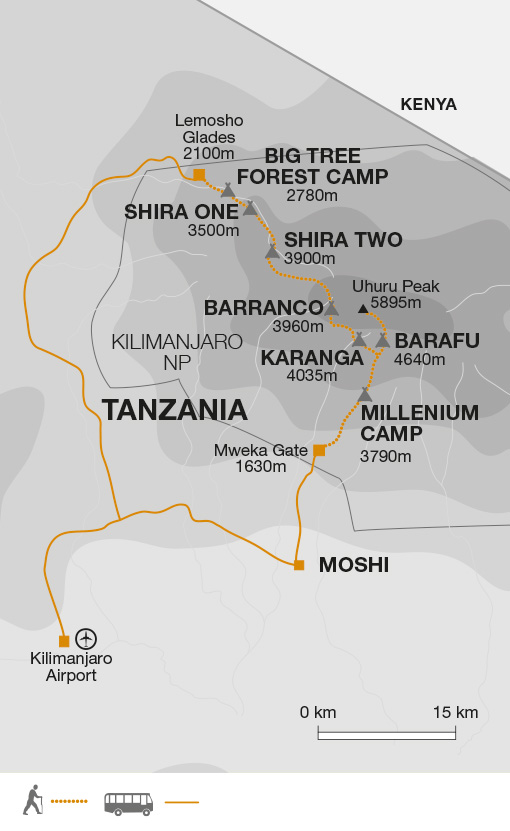Where is Mount Kilimanjaro?
Mount Kilimanjaro is located in north-east Tanzania, close to the border with Kenya.
How high is Mount Kilimanjaro?
Kilimanjaro sits 5,895 metres (19,341 feet) above sea level, making it the tallest mountain in Africa.
What is the best time time of year to climb Kilimanjaro?
Our trips run from July through to October and from the end of December to February to avoid the main rainy seasons; however it can still rain at any time on Kilimanjaro, and at the higher altitudes this may fall as snow. It's generally warmest in January and February and driest between August and October.
What is the best route up Mount Kilimanjaro?
There are several routes up Kilimanjaro, each differing in length and difficulty. On our Kilimanjaro trips we follow the Lemosho route, which involves a 7-day ascent. This route is longer and slower than the others, meaning you have plenty of time and don't have to rush. The Lemosho route gives you more time to acclimatise, reducing the chances of getting altitude sickness. We chose this route for our trips because it's safest, it maximises your time to enjoy the climb and it means our summit success rate is higher than average.

Will I get altitude sickness?
There is always a possibility of experiencing altitude sickness when climbing Kilimanjaro. However, by trekking the Lemosho route with us you'll make a slower ascent than other routes, giving you more time to acclimatise and reducing the chance of experiencing altitude sickness. We've also worked with Dr Jeremy Windsor, a high altitude medicine specialist, to careful plan the trekking days and camp sites.
All our trek leaders are trained in high altitude first aid and know the signs to look out for when Acute Mountain Sickness (AMS) may become more serious. In addition, all trek teams carry oxygen canisters and a portable hyberbaric (pressure) bag on the mountain for emergency use.
What should I pack for my Kilimanjaro trek?
In terms of clothing, you'll need to pack for every weather. From humid rainforest at the bottom, through desert-like terrain and finishing in very cold temperatures, your hike will travel through several different climates and conditions. Layers are essential so that you can add warmth as the temperature lowers the higher you get.
We'd recommend including the following:
- A thick jacket, like a down jacket
- A waterproof, windproof jacket
- A sturdy pair of walking boots that you've broken in before you travel
- Hat and gloves (liner gloves as well as a thick pair)
- Thick socks
- Thermal underwear
- Wicking t-shirts
- Lightweight walking trousers
- Long-sleeve shirts (to protect against insect bites)
For equipment, be sure to include:
- A head torch (and spare batteries)
- A very warm sleeping bag - a 4-season bag or a 3-season sleeping bag with a liner (silk adds a season)
- Walking poles with rubber tips
- Water bottles - at least 2 x 2 litre bottles (or a hydration bladder)
For more guidance on what to pack, check out our How to prepare for a Kilimanjaro trek blog post.
What will I eat?
Our cook and camp crew will prepare your meals each day of the trek and you'll dine as a group in a large tent. The meals are hearty and nutritious to give you plenty of energy for the hikes. You can expect breakfast dishes including eggs and sausages, pancakes and porridge. For lunch and dinner you'll typically have soup to start, a main such as fish or meat with potatoes or rice and vegetables and at dinnertime a dessert like fruit or popcorn. Plus, at mealtimes there'll also always be a steady supply of water, coca tea, coffee or Milo, a delicious hot chocolate drink.
If you are vegetarian or vegan, or have any other dietary requirements, please let us know when you book and we'll ensure our porters know.
Where will I sleep?
You'll camp each night of the trek, in tents that are provided and pitched for you by the porters. We provide two-person tents so you'll share with another person of the same sex, or you can pay an additional cost for our single room option and get a tent to yourself (and your own hotel room pre- and post-trek).
How can I prepare for climbing Kilimanjaro?
Discover our tips for preparing to climb Kilimanjaro on our blog.